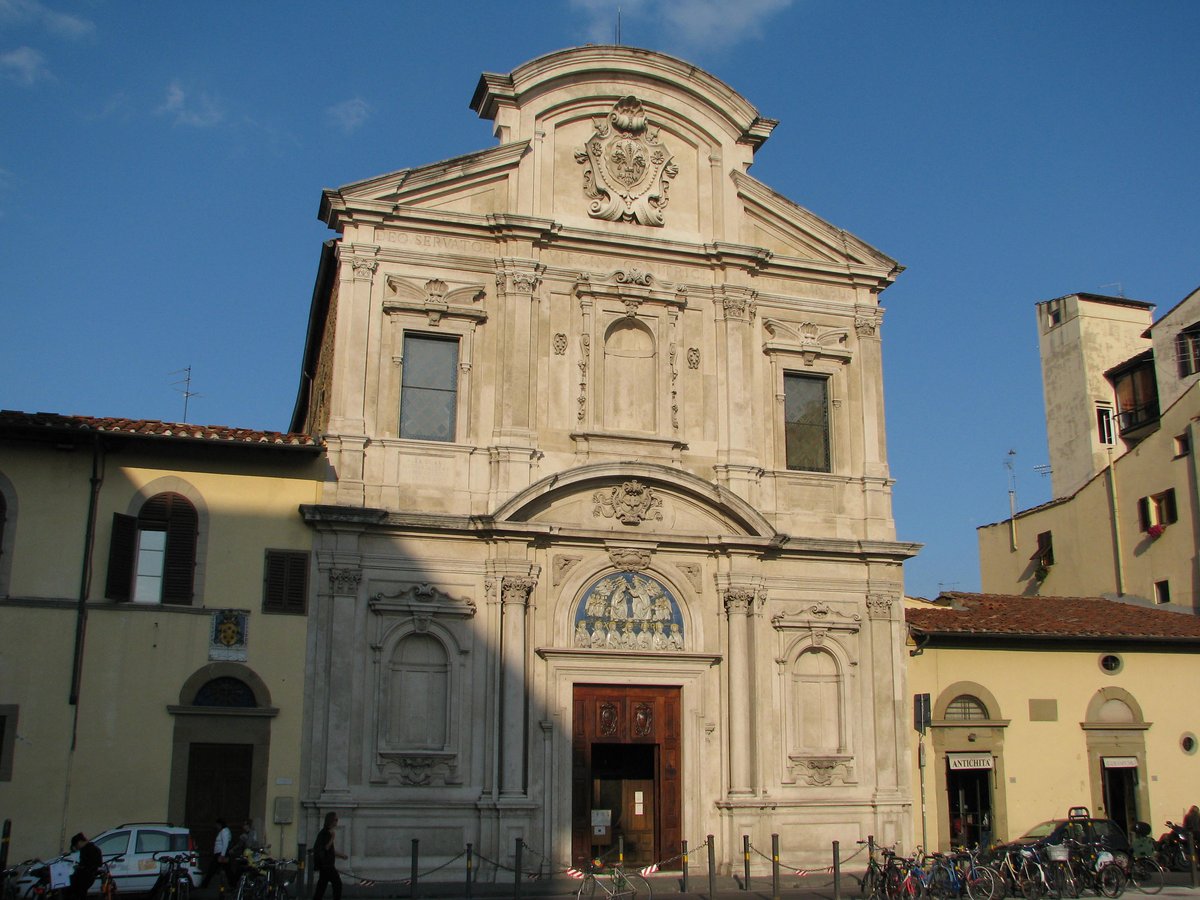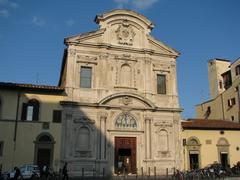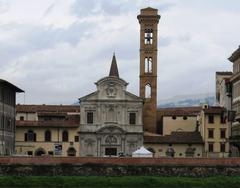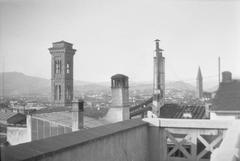
Ognissanti Church Florence: Visiting Hours, Tickets, and Historical Sites Guide
Date: 14/06/2025
Introduction
Nestled in the heart of Florence, the Church of Saint Salvatore of Ognissanti (Chiesa di Ognissanti) is a remarkable testament to the city’s religious, artistic, and architectural heritage. Founded in the 13th century by the Humiliati—a lay religious order devoted to poverty and community—the church has evolved through the centuries, reflecting Florence’s shifting cultural landscape. Its unique blend of Romanesque foundations and pioneering Baroque redesigns, particularly the ornate façade by Matteo Nigetti (1637), distinguishes Ognissanti from Florence’s more common Renaissance and Gothic landmarks (FlorenceTips.com).
Ognissanti is not only architecturally significant but also a sanctuary for Renaissance art, featuring masterpieces by Giotto, Botticelli, and Ghirlandaio. These treasures offer an intimate look into the innovations that shaped Western art. Located near the Arno River and major attractions like Ponte Vecchio and Palazzo Pitti, Ognissanti is accessible and central to Florence’s cultural life. This comprehensive guide provides detailed historical context, practical visitor information, and tips to help you make the most of your visit (Love from Tuscany; Visit Florence; Campus Florence; Florence Tourism Official).
Contents
- Introduction
- Historical Overview
- Origins and Foundation
- Transition and Rededication
- Architectural Evolution
- Artistic Significance
- Role in Florentine History
- Visiting Information
- Opening Hours
- Tickets and Admission
- Accessibility
- How to Get There
- Nearby Attractions
- Visual Highlights
- FAQs
- Preservation and Restoration
- Visitor Experience: Architectural Appreciation
- Conclusion
- References
Historical Overview
Origins and Foundation
Founded around 1239 by the Humiliati, the Ognissanti Church was constructed outside Florence’s ancient walls as part of a larger monastic complex. Its Romanesque structure, begun in 1251, reflected the Humiliati’s focus on poverty and communal life. The church’s original dedication to All Saints embodied the order’s inclusive spiritual mission and Florence’s emerging social fabric.
Transition and Rededication
The Humiliati were suppressed in 1571 by Cosimo I de’ Medici. The Franciscans then assumed control, rededicating the church to San Salvatore (the Holy Savior) in 1582, and enhancing the complex with two cloisters. This transition deepened Ognissanti’s commitment to social service and spiritual outreach.
Architectural Evolution
- Romanesque Beginnings: The 13th-century church featured a modest single nave and understated decoration.
- Baroque Transformation: In 1627, architect Matteo Segaloni, under the patronage of Ferdinando II de’ Medici, redesigned the interior in the Baroque style, introducing dramatic altars and rich artwork. The 1637 façade by Matteo Nigetti, with its three tiers and Benedetto Buglioni’s “Coronation of the Virgin and Saints,” remains an early and prominent example of Baroque architecture in Florence.
- 19th-Century Restoration: The façade was restored with travertine in 1872, preserving its Baroque grandeur (FlorenceTips.com).
Artistic Significance
Ognissanti is renowned for its exceptional collection of Renaissance masterpieces:
- Giotto’s Crucifix (Crocifisso di Ognissanti): Dating to c. 1315, this monumental wooden crucifix in the left transept is celebrated for its emotional resonance and innovative use of color, marking a pivotal move from Byzantine to Renaissance art (Love from Tuscany; Tuscany Planet).
- Botticelli’s “Saint Augustine in His Study”: This 1480 fresco, found on the right nave, presents a humanistic portrayal of the saint, reflecting the intellectual spirit of the Renaissance (Museums in Florence).
- Ghirlandaio’s “Saint Jerome” and Vespucci Chapel: Opposite Botticelli’s work is Ghirlandaio’s contemplative “Saint Jerome” fresco and the Vespucci Chapel, with the “Madonna della Misericordia” and a poignant “Deposition” (Love from Tuscany).
- Ghirlandaio’s “Last Supper”: Located in the former refectory, this 1480 fresco is noted for its naturalistic light and psychological depth. Access is limited to select mornings monthly and is free, but advance planning is required (Visit Florence).
- Giotto’s “Madonna and Child with Angels”: Once on the high altar, now in the Uffizi Gallery, this work exemplifies Ognissanti’s centrality in Florentine art history (Florence On Line).
- Taddeo Gaddi’s Crucifixion: The sacristy showcases 14th-century frescoes by Gaddi, a pupil of Giotto (Museums in Florence).
- Florentine Mosaic Main Altar: The main altar features commesso fiorentino, a mosaic technique using semi-precious stones (Love from Tuscany).
- Additional Treasures: The church also houses a bronze trunk containing Saint Francis’ robe, vibrant ceiling frescoes, and works by Santi di Tito, Maso da San Friano, and Matteo Rosselli (Tuscany Planet).
The adjacent cloisters, adorned with frescoes by Jacopo Ligozzi and Giovanni da San Giovanni, provide a tranquil setting for reflection (Churches of Florence).
Role in Florentine History
Ognissanti has served as a spiritual and community hub, hosting charitable and educational activities. Important families, such as the Vespucci—whose member Amerigo Vespucci was baptized here—patronized the church and its artwork. Ognissanti’s Baroque façade broke new ground in Florence and influenced later architectural developments in the city.
Visiting Information
Opening Hours
- General Opening: Tuesday to Sunday, 10:00 AM – 5:00 PM.
- Refectory (Last Supper fresco): Open select mornings monthly; check the official website or local tourist information for details.
- Religious Services: Schedules for Mass and special events are posted on the church’s website.
Tickets and Admission
- Church Entrance: Free; donations are appreciated for ongoing preservation.
- Guided Tours: Available for a fee and can be booked through the church website or local tour operators.
- Special Access: The Last Supper fresco is free to view, but access is limited and advance planning is required.
Accessibility
- The main church and most chapels are wheelchair accessible, with ramps at the entrance. Some historic areas, such as the refectory, may be less accessible—check in advance for assistance.
How to Get There
- Location: Piazza Ognissanti, Florence.
- On Foot: 10-minute walk from Ponte Vecchio and central Florence.
- By Bus: Lines 6, 12, 13, and 14 stop nearby.
Nearby Attractions
- Ponte Vecchio
- Palazzo Pitti and Boboli Gardens
- Santa Maria Novella Church
- Florence historic center shops and cafés
Visual Highlights
Admire the dynamic Baroque façade, the medieval campanile, the beautifully coffered nave ceiling, and Renaissance masterpieces throughout the church and refectory.
Frequently Asked Questions (FAQs)
Q: Is there an entrance fee to visit Ognissanti Church?
A: Entry is free; donations are welcome.
Q: When is Ghirlandaio’s “Last Supper” accessible?
A: Limited to select mornings each month; check the official site for details.
Q: Is the church wheelchair accessible?
A: Most areas are, but some historic sections may have limitations.
Q: Are guided tours available?
A: Yes, in English and other languages; book in advance.
Q: Can I take photos inside the church?
A: Non-flash photography is permitted; tripods require permission.
Q: Is the church suitable for families?
A: Absolutely—children are welcome and educational materials are available.
Preservation and Restoration
Ognissanti has benefited from ongoing restoration campaigns to conserve its architectural and artistic treasures, including the stabilization of the campanile, cleaning of Baroque stuccoes, and restoration of frescoes and altarpieces. These efforts ensure the church remains a vibrant place of worship and a living museum (FlorenceTips.com; Florence Tourism Official).
Visitor Experience and Architectural Appreciation
The interplay of medieval and Baroque elements, world-class artworks, and harmonious proportions make Ognissanti a unique destination for architectural and art enthusiasts. Visit during daylight hours for optimal lighting. Respectful attire is required, and local customs should be observed (The Florence Insider).
Plan Your Visit
Discover Florence’s spiritual and artistic legacy at Ognissanti Church. Download the Audiala app for guided tours and up-to-date visitor information, and follow local cultural platforms for event updates.
Summary and Further Exploration
The Church of Saint Salvatore of Ognissanti stands out for its architectural innovation, artistic treasures, and enduring role in Florence’s cultural tapestry. Its unique Baroque façade and harmonious interiors, coupled with masterpieces by Giotto, Botticelli, and Ghirlandaio, make it a must-visit for anyone interested in Florence’s history and art. With free admission, accessible facilities, and proximity to other landmarks, Ognissanti is an enriching addition to any Florence itinerary (FlorenceTips.com; Love from Tuscany; Visit Florence; Campus Florence; Florence Tourism Official).
References
- FlorenceTips.com
- Love from Tuscany
- Visit Florence
- Campus Florence
- Florence Tourism Official
- Tuscany Planet
- Museums in Florence
- Florence On Line
- Churches of Florence
- Florence Life
- The Florence Insider
For more on Florence historical sites and travel tips, explore related articles and download the Audiala app for personalized recommendations and guided tours.









































































